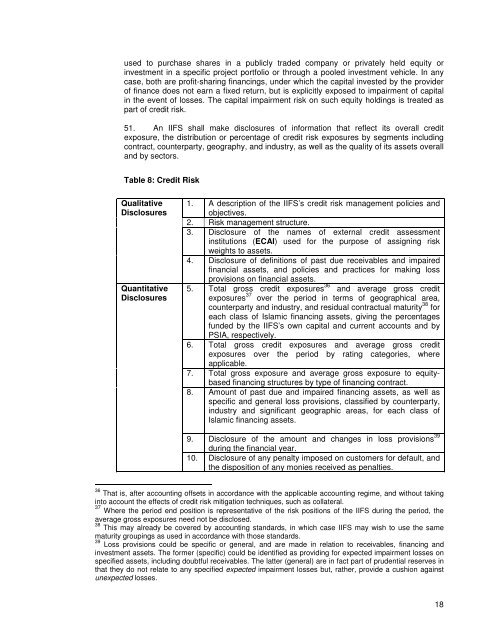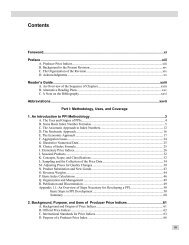Disclosures to Promote Transparency and Market - IFSB
Disclosures to Promote Transparency and Market - IFSB
Disclosures to Promote Transparency and Market - IFSB
You also want an ePaper? Increase the reach of your titles
YUMPU automatically turns print PDFs into web optimized ePapers that Google loves.
used <strong>to</strong> purchase shares in a publicly traded company or privately held equity or<br />
investment in a specific project portfolio or through a pooled investment vehicle. In any<br />
case, both are profit-sharing financings, under which the capital invested by the provider<br />
of finance does not earn a fixed return, but is explicitly exposed <strong>to</strong> impairment of capital<br />
in the event of losses. The capital impairment risk on such equity holdings is treated as<br />
part of credit risk.<br />
51. An IIFS shall make disclosures of information that reflect its overall credit<br />
exposure, the distribution or percentage of credit risk exposures by segments including<br />
contract, counterparty, geography, <strong>and</strong> industry, as well as the quality of its assets overall<br />
<strong>and</strong> by sec<strong>to</strong>rs.<br />
Table 8: Credit Risk<br />
Qualitative<br />
<strong>Disclosures</strong><br />
Quantitative<br />
<strong>Disclosures</strong><br />
1. A description of the IIFS’s credit risk management policies <strong>and</strong><br />
objectives.<br />
2. Risk management structure.<br />
3. Disclosure of the names of external credit assessment<br />
institutions (ECAI) used for the purpose of assigning risk<br />
weights <strong>to</strong> assets.<br />
4. Disclosure of definitions of past due receivables <strong>and</strong> impaired<br />
financial assets, <strong>and</strong> policies <strong>and</strong> practices for making loss<br />
provisions on financial assets.<br />
5. Total gross credit exposures 36 <strong>and</strong> average gross credit<br />
exposures 37 over the period in terms of geographical area,<br />
counterparty <strong>and</strong> industry, <strong>and</strong> residual contractual maturity 38 for<br />
each class of Islamic financing assets, giving the percentages<br />
funded by the IIFS’s own capital <strong>and</strong> current accounts <strong>and</strong> by<br />
PSIA, respectively.<br />
6. Total gross credit exposures <strong>and</strong> average gross credit<br />
exposures over the period by rating categories, where<br />
applicable.<br />
7. Total gross exposure <strong>and</strong> average gross exposure <strong>to</strong> equitybased<br />
financing structures by type of financing contract.<br />
8. Amount of past due <strong>and</strong> impaired financing assets, as well as<br />
specific <strong>and</strong> general loss provisions, classified by counterparty,<br />
industry <strong>and</strong> significant geographic areas, for each class of<br />
Islamic financing assets.<br />
9. Disclosure of the amount <strong>and</strong> changes in loss provisions 39<br />
during the financial year.<br />
10. Disclosure of any penalty imposed on cus<strong>to</strong>mers for default, <strong>and</strong><br />
the disposition of any monies received as penalties.<br />
36 That is, after accounting offsets in accordance with the applicable accounting regime, <strong>and</strong> without taking<br />
in<strong>to</strong> account the effects of credit risk mitigation techniques, such as collateral.<br />
37 Where the period end position is representative of the risk positions of the IIFS during the period, the<br />
average gross exposures need not be disclosed.<br />
38 This may already be covered by accounting st<strong>and</strong>ards, in which case IIFS may wish <strong>to</strong> use the same<br />
maturity groupings as used in accordance with those st<strong>and</strong>ards.<br />
39 Loss provisions could be specific or general, <strong>and</strong> are made in relation <strong>to</strong> receivables, financing <strong>and</strong><br />
investment assets. The former (specific) could be identified as providing for expected impairment losses on<br />
specified assets, including doubtful receivables. The latter (general) are in fact part of prudential reserves in<br />
that they do not relate <strong>to</strong> any specified expected impairment losses but, rather, provide a cushion against<br />
unexpected losses.<br />
18
















